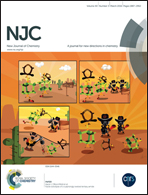Physicoelectrochemical properties of facilely electrosynthesized reduced graphene oxide/p-type conductive polymer nanocomposite film
Abstract
As electro-active electrodes, composites of reduced graphene oxide and poly ortho aminophenol (POAP) with good uniformity are prepared by electropolymerization and characterized by surface analysis, a fractal approach and conventional electrochemical methods. Density functional theory and optical modeling have been used for calculating thermodynamic parameters during polymerization and the band gap of the composite film. Calculated absorbance spectra as a function of wavelength and a plot of (αhν)2vs. photon energy for the three-component composite, using extended Bruggeman theory, are depicted and values of the energy, Eg, of the composite were determined as Eg1 = 3.81 eV and Eg2 = 2.66 eV. According to previous electrochemical results, rGO/POAP films have high fractal dimensions and large specific surface areas, which can be employed as efficient electrode materials in supercapacitors. In comparison with a Ni-POAP electrode, a Ni-rGO/POAP-modified electrode shows a higher response for methanol oxidation. A mechanism based on the electro-chemical generation of Ni(III) active sites and their subsequent consumption by methanol has been discussed. The ease of synthesis, high active surface area and high electrocatalytic activity of the newly synthesized composite are the main important factors in the presented study.


 Please wait while we load your content...
Please wait while we load your content...